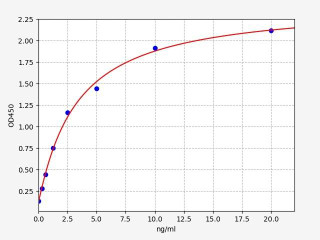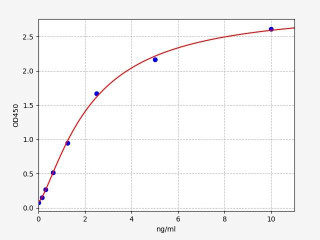CD11b: Macrophages and Microglia Marker
The immune system plays a critical role in defending the body against pathogens and maintaining tissue homeostasis. Within the intricate network of immune cells, CD11b, also known as integrin alpha M, emerges as a significant player in immunology and neuroscience. CD11b serves as a cell surface marker that aids in identifying and characterizing specific immune cell populations, particularly macrophages and microglia. Understanding the role of CD11b and its association with these cells provides valuable insights into various disease processes, immune responses, and neuroinflammatory disorders. In this blog post, we will look at the structure and function of CD11b, its significance as a marker for macrophages and microglia, and its relevance in scientific research.
Table of Contents
Jump to a section:
Key Takeaways
What is CD11b?
CD11b, a transmembrane glycoprotein, belongs to the integrin family, which comprises cell adhesion molecules involved in diverse cellular processes. Integrins function as heterodimers, consisting of an alpha and beta subunit. CD11b forms a heterodimer with the beta-2 subunit (CD18), resulting in the formation of the Mac-1 integrin, also referred to as complement receptor type 3 (CR3). CD11b/CD18 is primarily expressed on the surface of myeloid cells, including monocytes, granulocytes, macrophages, and microglia.
The key function of CD11b is to mediate cell adhesion and migration. By binding to various ligands, such as intercellular adhesion molecules (ICAMs) and complement component 3 (C3), CD11b facilitates the interaction between immune cells and their targets. Furthermore, CD11b plays a pivotal role in phagocytosis, the process by which cells engulf and eliminate foreign particles or debris.
Integrin alpha M/CD11b serves as the alpha subunit of the CD11b (integrin αM)/CD18 (integrin β2) heterodimer, providing structural integrity and ligand-binding capabilities to this receptor. Through its association with CD18, Integrin alpha M contributes to the adhesive and migratory properties of myeloid cells, enabling their participation in immune responses and tissue homeostasis.
Scematic of integrin αMβ2, consisting of CD11b and CD18
CD11b as a Marker for Macrophages
Macrophages, a vital component of the immune system, are highly versatile cells that participate in host defense, tissue repair, and immune regulation. CD11b serves as a reliable marker for identifying and studying macrophages due to its predominant expression on these cells. By targeting CD11b using specific antibodies, researchers can discern macrophages from other immune cell types and investigate their involvement in various physiological and pathological processes.
Macrophages expressing CD11b are found in various tissues, including the liver, spleen, lungs, and brain. Their ability to phagocytose pathogens, present antigens, and produce inflammatory mediators makes them crucial for innate immune responses. CD11b-positive macrophages play a significant role in tissue inflammation, wound healing, and the resolution of infections.
CD11b as a Marker for Microglia
Microglia, the resident immune cells of the central nervous system (CNS), play a crucial role in maintaining CNS homeostasis, neurodevelopment, and neuroinflammation. CD11b has emerged as a valuable marker for identifying and characterizing microglia due to its high expression on these cells. Microglia express CD11b in their resting state, and its levels increase upon activation or during neuroinflammatory processes.
The expression of CD11b on microglia is closely associated with their functional states. Resting microglia, characterized by ramified morphology, exhibit low levels of CD11b expression. However, upon activation in response to pathological insults, such as injury, infection, or neurodegenerative conditions, microglia undergo morphological changes and upregulate CD11b expression. This upregulation of CD11b serves as an indicator of microglial activation and their transition to an amoeboid or phagocytic phenotype, allowing them to respond to CNS damage or inflammation.
CD11b on microglia plays a critical role in mediating microglial functions, including migration, phagocytosis, antigen presentation, and the production of pro-inflammatory or anti-inflammatory factors. The ability to specifically target CD11b has enabled researchers to investigate the role of microglia in neuroinflammatory disorders such as Alzheimer's disease, Parkinson's disease, multiple sclerosis, and stroke.
CD11b Expression on Other Cell Types
1. CD11b and Neutrophils
Neutrophils, a type of white blood cell, also express CD11b. CD11b plays a crucial role in neutrophil function, including adhesion, migration, and phagocytosis. CD11b facilitates neutrophil attachment to the endothelium at sites of infection or inflammation, allowing them to migrate to the site of injury. Moreover, CD11b is involved in the recognition and engulfment of pathogens by neutrophils, contributing to their antimicrobial activity.
2. CD11b and Monocytes
Monocytes, the precursors to tissue macrophages, express CD11b. CD11b plays a significant role in monocyte recruitment, adhesion, and migration across endothelial barriers. CD11b facilitates monocyte attachment to activated endothelium via interactions with cellular adhesion molecules. Additionally, CD11b contributes to the monocyte extravasation into tissues during the inflammatory response. Once in the tissues, monocytes differentiate into tissue macrophages, where CD11b continues to play a role in their functioning.
3. CD11b and Dendritic Cells
Certain subsets of dendritic cells express CD11b, a molecule involved in their interactions with other immune cells and antigen presentation. CD11b contributes to the migration of dendritic cells to peripheral tissues, facilitating their surveillance of the environment for potential antigens. In addition, CD11b on dendritic cells is involved in the capture, processing, and presentation of antigens to T cells, initiating adaptive immune responses. CD11b-expressing dendritic cells are critical for bridging innate and adaptive immunity.
4. CD11b and Eosinophils
Eosinophils, specialized white blood cells involved in allergic responses and defense against parasitic infections, express CD11b. CD11b is involved in eosinophil adhesion to endothelial cells, allowing their migration into inflamed tissues. CD11b-mediated interactions with endothelial cell receptors facilitate the extravasation of eosinophils from the bloodstream into tissues. In addition to their role in allergic responses, eosinophils with CD11b expression may participate in immune surveillance and modulate immune responses during parasitic infections.
5. CD11b and NK Cells
In addition to its association with macrophages and microglia, CD11b also plays a role in the biology of natural killer (NK) cells. NK cells are a specialized subset of lymphocytes that participate in innate immune responses against infected or transformed cells. While CD11b is not uniformly expressed on all NK cells, a distinct subset of NK cells, often referred to as CD11b+ NK cells, exhibits CD11b surface expression. CD11b+ NK cells represent a unique subset within the NK cell population with distinct functional properties. These cells are characterized by enhanced cytotoxicity and cytokine production compared to their CD11b- counterparts. CD11b+ NK cells have been implicated in various immune responses, including tumor surveillance, viral infections, and autoimmune diseases.
Overview of Integrins
CD11b Related Kits

| Human ITGAM / CD11b ELISA Kit | |
|---|---|
| ELISA TYPE | Sandwich |
| SENSITIVITY | 0.188ng/ml |
| RANGE | 0.313-20ng/ml |

| Human CD68 / Macrosialin ELISA Kit | |
|---|---|
| ELISA TYPE | Sandwich |
| SENSITIVITY | 0.188ng/ml |
| RANGE | 0.313-20ng/ml |

| Human CEACAM-1 / CD66a ELISA Kit | |
|---|---|
| ELISA TYPE | Sandwich |
| SENSITIVITY | 0.094ng/ml |
| RANGE | 0.156-10ng/ml |
Therapeutic Significance of CD11b
CD11b, as a key molecule in immune cell function, holds therapeutic significance in various diseases, including tumors and systemic lupus erythematosus (SLE).
CD11b in Tumor Immunity
In the context of tumor immunity, CD11b plays a complex role. It is expressed on tumor-associated macrophages (TAMs), a subset of macrophages that infiltrate the tumor microenvironment. TAMs, often characterized by an immunosuppressive phenotype, can promote tumor growth, angiogenesis, and immune evasion. CD11b on TAMs contributes to their recruitment to the tumor site, interaction with other immune cells, and modulation of the tumor microenvironment. Targeting CD11b in tumor immunotherapy has shown promising potential. By blocking CD11b or depleting CD11b-expressing TAMs, researchers aim to disrupt the immunosuppressive tumor microenvironment and enhance antitumor immune responses.
CD11b in Systemic Lupus Erythematosus
Systemic lupus erythematosus (SLE) is a chronic autoimmune disease characterized by dysregulated immune responses and the production of autoantibodies. CD11b has been implicated in the pathogenesis of SLE, particularly in the activation of immune cells and the promotion of inflammation.
In SLE, CD11b expression is upregulated on various immune cells, including monocytes, neutrophils, and dendritic cells. This upregulation of CD11b is associated with increased adhesion, migration, and antigen presentation, contributing to the aberrant immune responses seen in SLE. Additionally, CD11b on immune cells can interact with complement component C3, forming the C3b-CD11b complex, which further perpetuates inflammation and tissue damage.
Targeting CD11b has emerged as a potential therapeutic strategy in SLE. By blocking CD11b-mediated interactions or modulating CD11b expression, researchers aim to attenuate immune cell activation, reduce inflammation, and restore immune homeostasis. Preclinical studies have shown promising results in murine models of SLE, demonstrating improved disease manifestations and reduced autoantibody production. However, further research and clinical trials are needed to validate the therapeutic efficacy and safety of targeting CD11b in SLE patients.
Research Applications of CD11b
The unique expression pattern of CD11b on macrophages and microglia has paved the way for numerous research applications in immunology and neuroscience. By employing CD11b antibodies, researchers can harness its specificity to investigate cellular interactions, immune responses, and disease mechanisms. Here are some notable research applications and techniques that utilize CD11b:
-
Immunohistochemistry and Immunofluorescence: CD11b antibodies enable the visualization and identification of macrophages and microglia in tissue sections or cell cultures. These techniques help researchers study the distribution, localization, and activation states of these cells in various physiological and pathological conditions.
-
Flow Cytometry: CD11b antibodies are widely employed in flow cytometry to analyze and sort specific immune cell populations. By combining CD11b staining with other markers, researchers can characterize macrophages and microglia subsets, investigate immune cell phenotypes, and study their response to stimuli.
-
In vivo Imaging and Tracking: Utilizing CD11b-targeting antibodies coupled with imaging techniques, such as in vivo microscopy or positron emission tomography (PET), allows researchers to monitor the migration, recruitment, and activation of macrophages and microglia in live animals. These studies provide insights into the spatiotemporal dynamics of these cells in disease models and help evaluate potential therapeutic interventions.
-
Gene Expression Analysis: By isolating CD11b-positive cells using fluorescence-activated cell sorting (FACS) or magnetic-activated cell sorting (MACS), researchers can perform gene expression profiling to unravel the molecular signatures and functional pathways associated with macrophages and microglia. This approach aids in identifying novel therapeutic targets and biomarkers for immune-related disorders.
Written by Lauryn McLoughlin
Lauryn McLoughlin completed her undergraduate degree in Neuroscience before completing her masters in Biotechnology at University College Dublin.
Recent Posts
-
Enavatuzumab: Revolutionizing Cancer Research Through Novel Therapeutics
Quick Facts About EnavatuzumabWhat is Enavatuzumab?Enavatuzumab is a monoclonal antibo …17th Dec 2025 -
Alemtuzumab: Mechanism, Applications, and Biosimilar Advancements
Quick Facts About AlemtuzumabWhat is Alemtuzumab?Alemtuzumab is a monoclonal antibody …17th Dec 2025 -
Validation of MycoGenie Rapid Mycoplasma Detection Kit - A highly sensitive visual determination method for Mycoplasma detection.
The MycoGenie Rapid Mycoplasma Detection Kit enables the detection of 28 Mycoplasma sp …3rd Mar 2025




